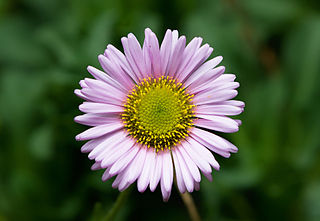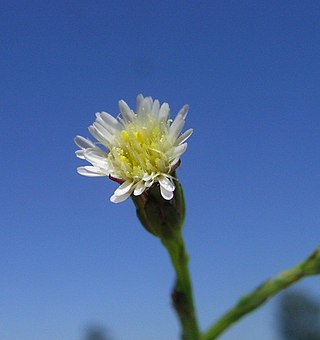
Solidago, commonly called goldenrods, is a genus of about 100 to 120 species of flowering plants in the family Asteraceae. Most are herbaceous perennial species found in open areas such as meadows, prairies, and savannas. They are mostly native to North America, including Mexico; a few species are native to South America and Eurasia. Some American species have also been introduced into Europe and other parts of the world.

Ptilimnium is a group of plants in the family Apiaceae described as a genus in 1819. The common name is mock bishopweed or mock bishop's weed. It is endemic to the United States, primarily in the Southeast, the Lower Mississippi Valley, and the Lower Great Plains.

Gnaphalium is a genus of flowering plants in the family Asteraceae, commonly called cudweeds or (formerly) chafeweeds. They are widespread and common in temperate regions, although some are found on tropical mountains or in the subtropical regions of the world.

Symphyotrichum is a genus of over 100 species and naturally occurring hybrids of herbaceous annual and perennial plants in the composite family, Asteraceae, most which were formerly treated within the genus Aster. The majority are endemic to North America, but several also occur in the West Indies, Central and South America, as well as one species in eastern Eurasia. Several species have been introduced to Europe as garden specimens, most notably New England aster and New York aster.

Astereae is a tribe of plants in the family Asteraceae that includes annuals, biennials, perennials, subshrubs, shrubs, and trees. They are found primarily in temperate regions of the world. Plants within the tribe are present nearly worldwide divided into over 250 genera and more than 3,100 species, making it the second-largest tribe in the family behind Senecioneae.

Ericameria nauseosa, commonly known as chamisa, rubber rabbitbrush, and gray rabbitbrush, is a shrub in the sunflower family (Aster) found in the arid regions of western North America.

Pseudognaphalium is a genus of flowering plants in the sunflower family. Members of the genus are commonly known as cudweeds or rabbit tobacco. They are widespread in tropical and temperate regions of many countries.

Galactia is a genus of plants in the legume family (Fabaceae). It belongs to the subfamily Faboideae and tribe Diocleae They do not have an unambiguous common name, being commonly called milk peas, beach peas or wild peas. They are perennial herbs or subshrubs with prostrate, climbing, or erect forms.
Keysseria (island-daisy) is a genus of flowering plants in the family Asteraceae. It includes 11 species, all of which are native to New Guinea with one species also native to northern Borneo.

Symphyotrichum subulatum, commonly known as eastern annual saltmarsh aster or, in Britain and Ireland where it is naturalized, annual saltmarsh aster, is an annual plant in the family Asteraceae native to the eastern United States and the Gulf Coast to Texas. The species grows primarily in coastal salt marshes, although in the Ozarks it occurs as a non-marine weedy variety.

Erythranthe, the monkey-flowers and musk-flowers, is a diverse plant genus with more than 120 members in the family Phrymaceae. Erythranthe was originally described as a separate genus, then generally regarded as a section within the genus Mimulus, and recently returned to generic rank. Mimulus sect. Diplacus was segregated from Mimulus as a separate genus at the same time. Mimulus remains as a small genus of eastern North America and the Southern Hemisphere. Molecular data show Erythranthe and Diplacus to be distinct evolutionary lines that are distinct from Mimulus as strictly defined, although this nomenclature is controversial.

Diplacus is a plant genus in the family Phrymaceae, which was traditionally placed in family Scrophulariaceae. In the 2012 restructuring of Mimulus by Barker, et al., based largely upon DNA evidence, seven species were left in Mimulus, 111 placed into Erythranthe, 46 placed into Diplacus, two placed in Uvedalia, and one each placed in Elacholoma, Mimetanthe, and Thyridia. Diplacus used to be a separate genus from Mimulus, but it was merged into Mimulus no later than 1905, until the 2012 restructuring. Dry and rocky areas are preferred.
Spermolepis inermis, the Red River scaleseed or spreading scaleseed, is a species of flowering plant in the family Apiaceae. It is native to the central and southeastern United States, and eastern Mexico. An annual reaching 3 ft (1 m), it is found in grasslands.
Pappochroma is a genus of flowering plants in the sunflower family, Asteraceae. It includes nine species native to southeastern Australia, including New South Wales, Victoria, and Tasmania.











